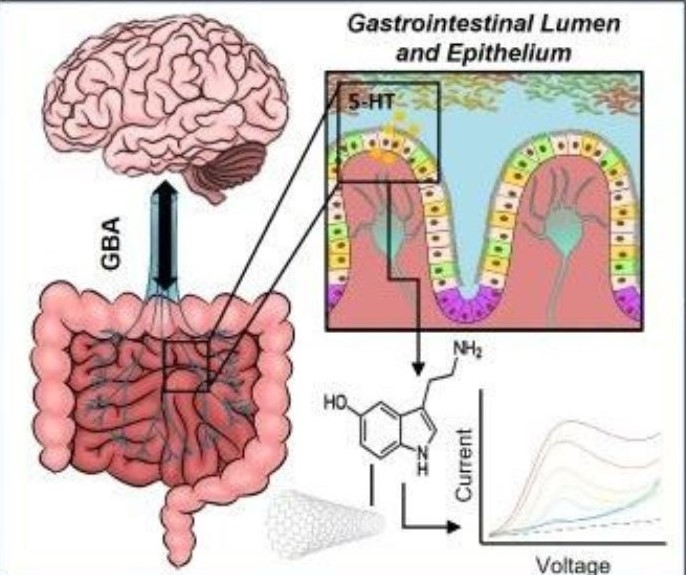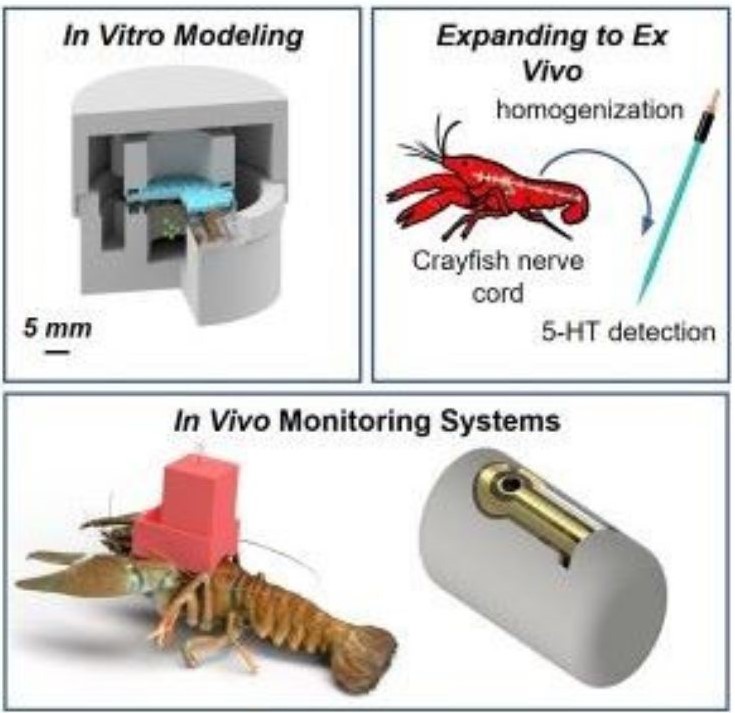 |
Two papers authored by UMD PhD students have been receiving attention for their work on the Gut-Microbiome-Brain-Axis (GMBA). The research for both papers was made possible by NSF’s Integrative Strategies for Understanding Neural and Cognitive Systems (NCS) program. The mission of the NCS program is to promote NSF’s research in the development of neurotechnologies, particularly through the Understanding the Brain program and the Brain Research through Advancing Innovative Neurotechnologies (BRAIN) Initiative. Both programs emphasize interdisciplinary research across the sciences and engineering.
The project, led by PI Reza Ghodssi (ECE/ISR/Fischell Institute/Bioengineering), is titled “Developing engineering solutions to investigate microbiome-to-neuron communication” and is focused on investigating the complex effects of intestinal serotonin on both gut and brain health, developing a realistic picture of the gut-microbiome-brain axis system (GMBA). The program was a joint effort with Co-PIs Jens Herberholz in neuroscience (Department of Psychology, CNS), Wolfgang Losert in data science (Physics/IPST/IREAP), and William Bentley in molecular biology (Fischell Institute/BioE/IBBR). solutions to investigate microbiome-to-neuron communication” and is focused on investigating the complex effects of intestinal serotonin on both gut and brain health, developing a realistic picture of the gut-microbiome-brain axis system (GMBA). The program was a joint effort with Co-PIs Jens Herberholz in neuroscience (Department of Psychology, CNS), Wolfgang Losert in data science (Physics/IPST/IREAP), and William Bentley in molecular biology (Fischell Institute/BioE/IBBR).
ACS Sensors featured the first paper, titled Simultaneous Dopamine and Serotonin Monitoring in Freely Moving Crayfish Using a Wireless Electrochemical Sensing System, on the highly visible inside cover page. The research focuses on the impact of dopamine (DA) and serotonin (5-HT) on physiological and behavioral processes. Jinjing Han (ECE/ISR/Fischell Institute), Ta-wen Ho (Program in Neuroscience and Cognitive Science), Justin M. Stine (ECE/ISR/Fischell Institute), and Sydney N. Overton (ECE/ISR/Fischell Institute), along with Professor Jens Herberholz and Professor Ghodssi, contributed to the work.
DA and 5-HT are neurotransmitters that modulate animal behaviors. In order to further investigate their neuromodulatory roles in real time, advanced micro-nano-bio devices are needed. The ACS Sensor paper described the fabrication of a compact, semi-implantable device used to detect DA and 5-HT with high sensitivity and selectivity in vivo. Attached to and tested on crayfish, the wireless device allows electrode implantation into the heart of the crayfish, allowing researchers to electrochemically monitor, in real time, injected DA and 5-HT in circulation. The proof-of-concept results demonstrated by the device provide a valuable tool to expand understanding how these neurotransmitters work together. Continued improvement of sensing sensitivity of the device and research in this area could result in the ability to monitor neurotransmitters associated with animal behaviors.
"The next challenge will be to further increase sensor sensitivity so that small fluctuations of internally produced neurotransmitters can be measured,” says Professor Herberholz. “This will open up exciting avenues for real-time, wireless monitoring of neuromodulation during naturally occurring behaviors, such as gut-derived hormonal effects on social interactions between multiple animals."
The second paper, published in IEEE Sensors, is titled Serotonin Sensing Technologies to Promote Understanding of the Gut-Brain Axis, and was authored by Overton, Han, Michael A. Straker (ISR/ Fischell Institute/Bioengineering), Joshua A. Levy (ISR/Fischell Institute/Materials Science), Stine, and Ho with Herberholz and Ghodssi.
 The publication highlights the group's work on unraveling the bidirectional biochemical signaling pathway between the gastrointestinal (GI) tract and the central nervous system, known as the gut-brain axis (GBA).The research group is developing sensing technologies to study the dynamics of the GBA and 5-HT, these technologies range from an in vitro planar sensor platform to a wearable sensing platform for in vivo studies, again using crayfish as their test species. The impact of their studies will improve understanding of the connection between the gut and the brain through the GBA, informing how conditions of the GI tract are linked to neurological conditions. The publication highlights the group's work on unraveling the bidirectional biochemical signaling pathway between the gastrointestinal (GI) tract and the central nervous system, known as the gut-brain axis (GBA).The research group is developing sensing technologies to study the dynamics of the GBA and 5-HT, these technologies range from an in vitro planar sensor platform to a wearable sensing platform for in vivo studies, again using crayfish as their test species. The impact of their studies will improve understanding of the connection between the gut and the brain through the GBA, informing how conditions of the GI tract are linked to neurological conditions.
The support of the NSF NCS award has allowed researchers to build a better understanding of the GMBA, allowing for future research in this complex field of study. Most notably, the associated research resulted in the development of the first wireless ingestible device for real-time quantification of 5-HT, which will be instrumental in clarifying the role of 5-HT in GI diseases.
“Working interactively with colleagues in the life sciences area is truly an exciting and rewarding experience for our engineering students and researchers,” said Ghodssi. “Our GMBA research project is an excellent example of how micro/nano/bio devices and systems could enable discovery that was not previously possible. While trying to understand and analyze the data we are measuring using these miniature sensor systems, we are continuously challenged to design, develop, and characterize better, more sensitive devices to meet our goals. We, engineers, can never do that on our own.”
May 28, 2024
|

